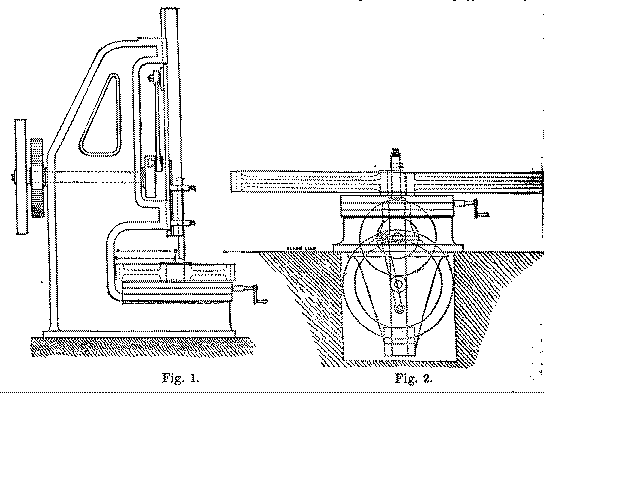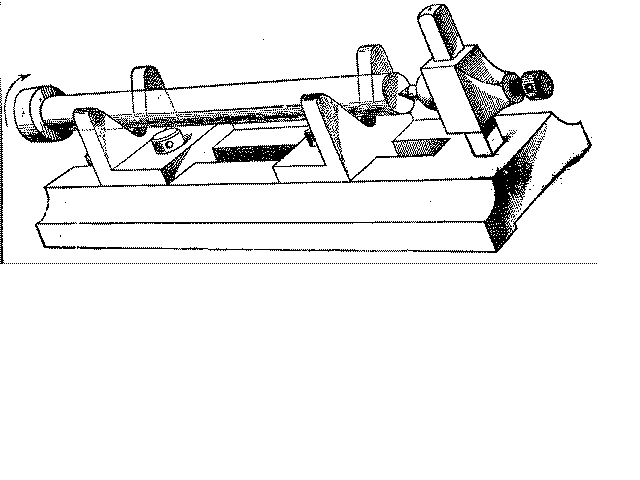In order to obviate this inconvenience, I designed an arrangement of a key-groove mortising machine. It was capable of operating upon wheels of any diameter, having no limit to it capacity in that respect. 'It was, at the same time, possessed in respect of the principle on which it was arranged, of the power of taking a much deeper cut, there being an entire absence of any source of springing or elasticity in its structure. This not only enabled the machine to perform its work with more rapidity, but also with more precision. Besides, it occupied much less space in the workshop, and did not cost above one-third of the machines formerly in use. It gave the highest satisfaction to those who availed themselves of its effective Services.

A comparison of Fig. 1 -- which represents the general arrangement of the machine in use previous to the introduction of mine -- with that of Fig. 2, may serve to convey some idea of their relative sizes. Fig. 1 shows a limit to the admission of wheels exceeding 6 feet diameter, Fig. 2 shows an unlimited capability in that respect.
An Instrument for finding and marking the Centres of Cylindrical Rods or Bolts about to be turned on the Lathe.
One of the most numerous details in the structure of all classes of machines is the bolts which serve to hold the various parts together. As it is most important that each bolt fits perfectly the hole it belongs to, it is requisite that each bolt should, by the process of turning, be made perfectly cylindrical. In preparing such bolts, as they come from the forge, in order to undergo the process of turning, they have to be "centred;" that is, each end has to receive a hollow conical indent, which must agree with the axis of the bolt. To find this in the usual mode, by trial and frequent error, is a most tedious process, and consumes much valuable time of the workman as well as his lathe.
 In order to obviate the necessity for this costly process, I devised the simple instrument, a drawing of
which is annexed. The use of this enabled any boy to find and mark with absolute exactness and rapidity
the centres of each end of bolts, or suchlike objects. All that was required was to place the body of the
bolt in the V-shaped supports, and to gently cause it to revolve, pressing it longitudinally against the
steel-pointed marker, which scratched a neat small circle in the true centre or axis of the bolt. This small
circle had its centre easily marked by the indent of a punch, and the work was thus ready for the lathe.
This humble but really important process was accomplished with ease, rapidity, and great economy.
In order to obviate the necessity for this costly process, I devised the simple instrument, a drawing of
which is annexed. The use of this enabled any boy to find and mark with absolute exactness and rapidity
the centres of each end of bolts, or suchlike objects. All that was required was to place the body of the
bolt in the V-shaped supports, and to gently cause it to revolve, pressing it longitudinally against the
steel-pointed marker, which scratched a neat small circle in the true centre or axis of the bolt. This small
circle had its centre easily marked by the indent of a punch, and the work was thus ready for the lathe.
This humble but really important process was accomplished with ease, rapidity, and great economy.
Improvement in Steam-Engine Pistons, and in Water and Air-Pump Buckets, so as to lessen Friction and dispense with Packing.
The desire to make the pistons of steam-engines and air-pump buckets of condensing engines perfectly steam and water tight has led to the contrivance of many complex and costly constructions for the purpose of packing them. When we take a commonsense view of the subject, we find that in most cases the loss of power resulting from the extra friction neutralises the expected saving. This is especially the case with the air-pump bucket of a condensing steam-engine, as it is in reality much more a water than an air pump. But when it is constructed with a deep well-fitted bucket, entirely without packing, the loss sustained by such an insignificant amount of leakage as may occur from the want of packing is more than compensated by the saving of power resulting from the total absence of friction.
The first condensing steam-engine to which I applied an air-pump bucket, entirely without packing, was the forty horsepower engine, which I constructed for the Bridgewater Foundry. It answered its purpose so well that, after twenty years' constant working , the air-pump cover was taken off, out of curiosity, to examine the bucket, when it was found in perfect order. This system, in which I dispensed with the packing for air-pump buckets of condensing steam-engines, I have also applied to the pistons of the steam cylinders, especially those of high-pressure engines of the smaller vertical construction, the stroke of which is generally short and rapid. Provided the cylinder is bored true, and the piston is carefully fitted, and of a considerable depth in proportion to its diameter, such pistons will be found to perform perfectly all their functions, and with a total absence of friction as a direct result of the absence of packing.
| Previous chapter/page | Back | Home | Email this | Search | Discuss | Bookmark | Next chapter/page |